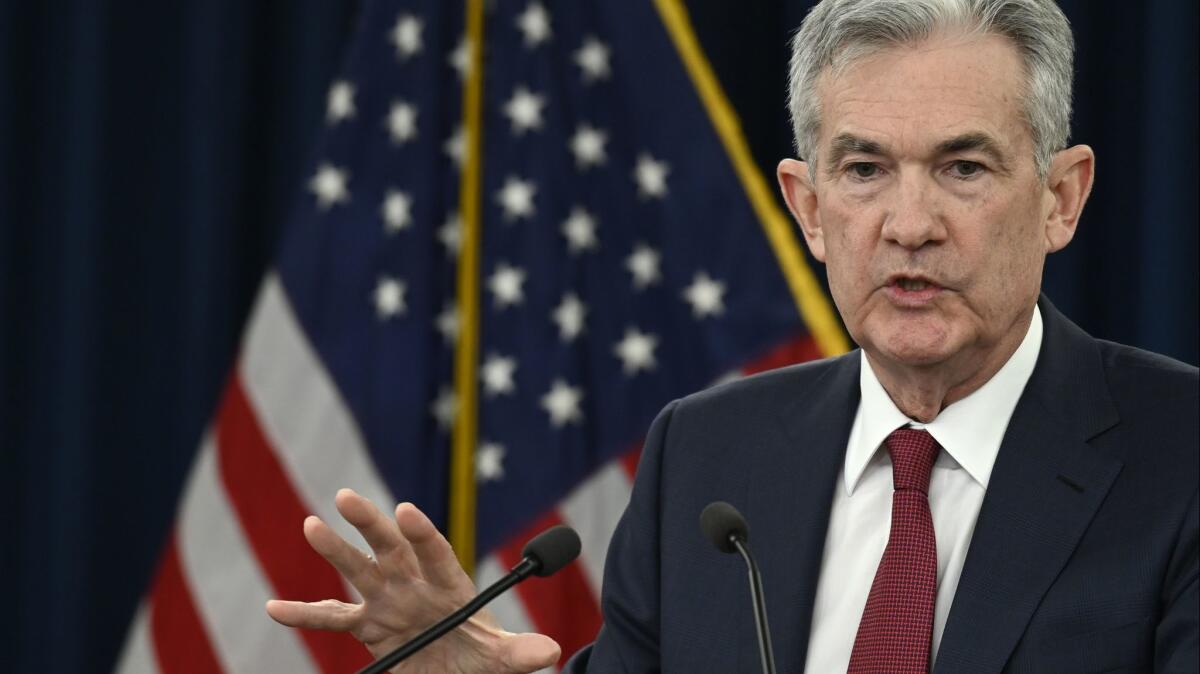Fed will buy more Treasury bills, but not at crisis-era levels, Jerome Powell says

- Share via
Federal Reserve Chairman Jerome Powell said the central bank will resume purchases of Treasury securities in an effort to avoid a repeat of recent turmoil in money markets. But he left options open on whether Fed policymakers will cut interest rates again at their meeting in a few weeks.
“My colleagues and I will soon announce measures to add to the supply of reserves over time,” he said in the text of a speech that was to be delivered Tuesday to the National Assn. of Business Economics in Denver.
He suggested that the purchases would be made up of Treasury bills and stressed that the buying should not be seen as a return of the crisis-era quantitative easing programs that the Fed engaged in a decade ago to boost the economy. Three-month bill yields fell on the comments.
“I want to emphasize that growth of our balance sheet for reserve management purposes should in no way be confused with the large-scale asset purchase programs that we deployed after the financial crisis,” Powell said. “Neither the recent technical issues nor the purchases of Treasury bills we are contemplating to resolve them should materially affect the stance of monetary policy.”
The Fed has cut interest rates twice this year to shelter the U.S. economy from weak global growth and trade-policy uncertainty. Traders in federal funds futures are betting that the Federal Open Market Committee will reduce rates again at its Oct. 29-30 meeting from the current target range of 1.75% to 2%. Futures were little changed after the release of Powell’s comments.
Powell was noncommittal on what the Fed’s next move would be.
“Looking ahead, policy is not on a preset course,” he said. “The next FOMC meeting is several weeks away, and we will be carefully monitoring incoming information.”
He said the actions the Fed has already taken “are providing support for the outlook,” which remains favorable but faces risks, principally from global developments such as trade and Britain’s pending withdrawal from the European Union.
But, he added, “we will act as appropriate to support continued growth, a strong job market, and inflation moving back to our symmetric 2% objective.”
The economy has recently shown signs of slowing as weakness overseas has spread to the United States and moved from domestic manufacturing industries to services.
The job market has also downshifted, even as unemployment has fallen to a half-century low of 3.5%. Nonfarm payrolls grew by an average of 157,000 per month in the third quarter, compared with gains above 200,000 earlier in the expansion.
Powell said that work done by the Fed mining private-sector data suggested that the most recent job gains may ultimately be revised lower, but that the pace would still be above the level needed to hold unemployment steady.
Money markets were roiled last month as a combination of corporate tax payments and the settlement of Treasury debt purchases temporarily sent short-term interest rates skyrocketing.
The Fed announced last week that it will extend through October the ad hoc liquidity lifeline that it has been offering to U.S. funding markets since then.
“We will not hesitate to conduct temporary operations if needed to foster trading in the federal funds market at rates within the target range,” Powell said.
“As we indicated in our March statement on balance sheet normalization, at some point, we will begin increasing our securities holdings to maintain an appropriate level of reserves,” he added. “That time is now upon us.”
More to Read
Inside the business of entertainment
The Wide Shot brings you news, analysis and insights on everything from streaming wars to production — and what it all means for the future.
You may occasionally receive promotional content from the Los Angeles Times.










